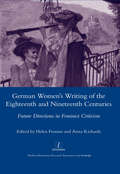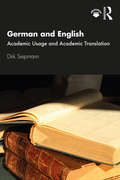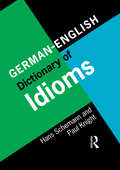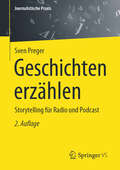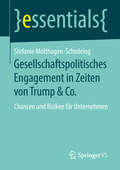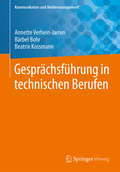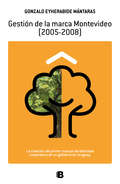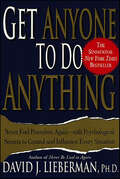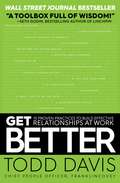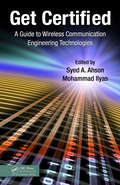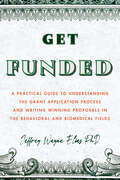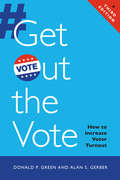- Table View
- List View
German Technical Dictionary: Universal-worterbuch Der Technik Englisch (Routledge Bilingual Specialist Dictionaries Ser.)
by RoutledgeSince its publication in 1995, the German Technical Dictionary has established itself as the definitive resource for anyone who needs to translate technical documents between German and English.This new edition has been substantially revised to reflect the technological environment of the twenty-first century. The revised edition contains over 75,000 entries, of which over 5,000 are new, with many new entries in the areas of:* the Internet and telecommunications* bio-technology and the new genetics* new developments in health technology.Throughout, this dictionary continues to benefit from the features that made the first edition so valuable, including accurate translations in British and American English and an attractive, durable and easy to use layout.
German Women's Writing of the Eighteenth and Nineteenth Centuries: Future Directions in Feminist Criticism
by Helen FroniusGerman women writers of the eighteenth and nineteenth centuries have been the subject of feminist literary critical and historical studies for around thirty years. This volume, with contributions from an international group of scholars, takes stock of what feminist literary criticism has achieved in that time and reflects on future trends in the field. Offering both theoretical perspectives and individual case studies, the contributors grapple with the difficulties of appraising 'non-feminist' women writers and genres from a feminist perspective and present innovative approaches to research in early women's writing. This inclusive and cross- disciplinary collection of essays will enrich the study of German women's writing of the eighteenth and nineteenth centuries and contribute to contemporary debates in feminist literary criticism. Anna Richards is Lecturer in German at Birkbeck College, University of London. Helen Fronius is College Lecturer in German at Keble College, University of Oxford.
German and English: Academic Usage and Academic Translation
by Dirk SiepmannGerman and English: Academic Usage and Academic Translation focuses on academic and popular scientific/academic usage.This book’s brief is both theoretical and practical: on the theoretical side, it aims to provide a systematic, corpus-based account of current academic usage in English and in German as well as of the translation problems associated with various academic genres; on the practical side, it seeks to equip academic translators with the skills required to produce target-language text in accordance with disciplinary conventions. The main perspective taken is that of a translator working from German into English, but the converse direction is also regularly taken into account. Most of the examples used are based on errors that occurred in real-life translation jobs. Additional practice materials and sample translations are available as eResources here: www.routledge.com/9780367619022.This book will be an important resource for professionals aspiring to translate academic texts, linguists interested in academic usage, translation scholars, and graduate and post-graduate students.
German/English Business Correspondence: Geschaftskorrespondenz Deutsch/Englisch
by Paul Hartley Gertrud RobinsGerman/English Business Correspondence is a handy reference and learning text for all who use written German. 80 written communications are simply presented covering memos, letters, faxes and resumes. The situations covered include: * arranging meetings * acknowledging orders * enquiring about products * applying for jobs With full English translations, this text is suitable for both students and professionals and can be used for either reference or class use.
German/English Business Glossary (Business Language Glossaries Ser.)
by Paul Hartley Gertrud RobinsThis is the essential reference companion to all who use German for business communication.Containing over 5000 words, this handy two-way A-Z glossary covers the most commonly used terms in business. It will help you to communicate with confidence in a wide variety of situations, and is of equal value to the relative beginner or the fluent speaker.Written by an experienced native and non-native speaker team working in business language education, this unique glossary is an indispensable reference guide for all students and professionals studying or working in business where German is used.
German/English Dictionary of Idioms: Supplement To The German/english Dictionary Of Idioms
by Hans SchemannThis unique dictionary covers all the major German idioms and is probably the richest source of contemporary German idioms available, with 33,000 headwords. Within each entry the user is provided with: English equivalents; variants; contexts and precise guidance on the degree of currency/rarity of an idiomatic expression. This dictionary is an essential reference for achieving fluency in the language. It will be invaluable for all serious learners and users of German. Not for sale in Germany, Austria and Switzerland.
German: An Essential Grammar (Routledge Essential Grammars)
by Bruce DonaldsonGerman: An Essential Grammar is a practical reference guide to the core structures and features of modern German. Presenting a fresh and accessible description of the language, this engaging grammar uses clear, jargon-free explanations and sets out the complexities of German in short, readable sections. Suitable for either independent study or for students in schools, colleges, universities and adult education classes, key features include: focus on the morphology and syntax of the language clear explanations of grammatical terms full use of authentic examples a detailed contents list and index for easy access to information. With an emphasis on the German native speakers use today, German: An Essential Grammar will help students to read, speak and write the language with greater confidence.
Geschichte (in) der Unternehmenskommunikation: Zur Entstehung von Unternehmens- und Strategischer Geschichtskommunikation
by Günter Bentele Felix KrebberDer Band vereint zwei Themen: Die Berufsfeldgeschichte von Public Relations und Unternehmenskommunikation sowie die Kommunikation historischer Themen im Rahmen der Unternehmenskommunikation. Zur Untersuchung der Entstehung von Unternehmenskommunikation im 19. Jahrhundert wird im ersten Teil ein historischer wie auch kommunikationswissenschaftlicher Rahmen aufgespannt. Fallstudien zur Entstehung der Kommunikationsarbeit bei Traditionsunternehmen geben Einblicke in die Geburtsstunden eines bis heute an Relevanz gewinnenden Berufsfeldes. Inhaltlicher Fokus des zweiten Teils ist die Frage, wie in der Unternehmenskommunikation Geschichte als Querschnittsthema über sämtliche Stakeholdergruppen hinweg integriert thematisiert wird. Hier werden aus einer kommunikationswissenschaftlichen Perspektive zunächst theoretisch berufliches Handlungsfeld, Ziele, Funktionen und Praktiken Strategischer Geschichtskommunikation (im Praxisdiskurs Corporate History Communication) beschrieben und anschließend anhand mehrerer Studien empirisch untersucht und anhand von Fallbeispielen anschaulich gemacht.
Geschichten erzählen: Storytelling für Radio und Podcast (Journalistische Praxis)
by Sven PregerEs gehört zu den schönsten und komplexesten Aufgaben in Podcast und Radio: spannende Geschichten zu erzählen. Wie kann ich Hörer*innen 15, 30 oder 60 Minuten an eine reale Geschichte binden? Oder gar für eine ganze Serie begeistern? Dieses Buch beschreibt den professionellen Weg zu einer spannenden Erzählung. Es gibt praxistaugliche Antworten auf alle entscheidenden Fragen: Welche Stoffe taugen für lange Geschichten? Wie halte ich die Spannung von Anfang bis Ende aufrecht? Wie finde ich meine Erzählstimme und klinge als Host natürlich? Und wie entwickelt man ein Sound Design für komplexe Erzählungen? Ein Praxis-Buch, mit dessen Hilfe sich die Potenziale von Podcast und Radio entfalten lassen. Die Website zum Buch bietet weiterführende Links und ergänzt aktuelle Entwicklungen. Für die zweite Auflage wurde der Band überarbeitet, aktualisiert und mit neuen Beispielen ergänzt.
Gesellschaftspolitisches Engagement in Zeiten von Trump & Co.: Chancen und Risiken für Unternehmen (essentials)
by Stefanie Molthagen-SchnöringStefanie Molthagen-Schnöring analysiert in diesem essential, warum und wie sich Unternehmen zu gesellschaftspolitischen Problemstellungen, z. B. Digitalisierung, gleichgeschlechtliche Ehe, Integration, positionieren. Sie fragt, wie sich dieses Engagement zu etablierten Aktivitäten wie Corporate Social Responsibility, Public Affairs und Unternehmenskommunikation/Marketing verhält und wie es in interne und externe (Kommunikations-)Prozesse eingebettet ist. Dabei beleuchtet sie Chancen und Risiken einer gesellschaftspolitischen Positionierung durch Unternehmen und betrachtet die Reaktionen wichtiger Stakeholder. Die Autorin arbeitet mit Beispielen und Stimmen von Expertinnen und Experten aus der Praxis.
Gesprächsführung in technischen Berufen
by Annette Verhein-Jarren Bärbel Bohr Beatrix KossmannDieser praxisnahe Gesprächsleitfaden wurde speziell für technische Berufe entwickelt. Er zeichnet sich durch den Bezug zum industriellen Umfeld aus und bietet zahlreiche Beispiele für Gesprächsanlässe und typische Gesprächsthemen.Praktische Hinweise zeigen, wie Gespräche konstruktiv genutzt werden können, um- Fachwissen auszubauen und zu teilen,- Ursachen von Missverständnissen zu erkennen, - Interessen überzeugend zu vertreten. Daneben bietet es die erforderlichen theoretischen Grundlagen.Die ZielgruppenDas Buch eignet sich gleichermaßen für Studierende sowie für junge Fachkräfte aus Ingenieurwesen und Technik.
Gestaltung digitalisierter Arbeitswelten: Handlungsfelder und Praxisbeispiele zur Umsetzung digitalisierter Arbeit (Intelligente Technische Systeme – Lösungen aus dem Spitzencluster it’s OWL)
by Roman DumitrescuIm Zukunftsprojekt Industrie 4.0 stand bisher die Frage im Fokus, was technisch möglich ist. Mit der Digitalisierung der Arbeit rücken allerdings soziale Aspekte der Arbeitsgestaltung verstärkt in den Vordergrund. Gebraucht werden innovative Konzepte für die Arbeit in produzierenden Unternehmen. Im Buch werden die Ergebnisse des Spitzencluster-Projekts »Gestaltung der Arbeitswelt in der Industrie vor dem Hintergrund der Digitalisierung« vorgestellt. Grundlage bildet eine durchgeführte Praxisstudie mit sechs Industrieunternehmen, in der die Herausforderungen einer digitalisierten Arbeitswelt untersucht und Potenziale aufgedeckt wurden. Die Autoren zeigen eine Systematik auf und belegen anhand von Praxisbeispielen, wie sie anzuwenden ist: Von der Definition von Zielzuständen über die Entwicklung und Einführung von Assistenzsystemen bis hin zur Arbeitsgestaltung und Organisationsentwicklung.Entstanden sind vielfältige anwendungsorientierte Methoden zum Umgang mit der zunehmenden Digitalisierung der Arbeit und praktische Leitfäden, um Produktions- und Organisationsprozesse nachhaltig zu verbessern und die Akzeptanz der Mitarbeiter zu erhöhen.Im Technologie-Netzwerk Intelligente Technische Systeme OstWestfalenLippe (kurz: it’s OWL) haben sich rund 200 Unternehmen, Hochschulen, Forschungseinrichtungen und Organisationen zusammengeschlossen, um gemeinsam den Innovationssprung von der Mechatronik zu intelligenten technischen Systemen zu gestalten. Gemeinsam entwickeln sie Ansätze und Technologien für intelligente Produkte und Produktionsverfahren, Smart Services und die Arbeitswelt der Zukunft. Das Spektrum reicht dabei von Automatisierungs- und Antriebslösungen über Maschinen, Fahrzeuge, Automaten und Hausgeräte bis zu vernetzten Produktionsanlagen und Plattformen. Dadurch entsteht eine einzigartige Technologieplattform, mit der Unternehmen die Zuverlässigkeit, Ressourceneffizienz und Benutzungsfreundlichkeit ihrer Produkte und Produktionssysteme steigern und Potenziale der digitalen Transformation erschließen können.
Gestión de la marca Montevideo (2005-2008): La creación del primer manual de identidad corporativa
by Gonzalo EyherabideUn estudio sobre el primer manual de estilo gráfico de la Intendencia de Montevideo. Hace doce años, la Intendencia de Montevideo lanzó una nueva marca ciudad e instrumentó un Programa Visual de Identidad Institucional basado en la creación de un equipo de gestión integrado por profesionales de la comunicación, y el desarrollo y puesta en práctica del primer manual de identidad corporativa generalista de un gobierno en Uruguay.El presente estudio consiste en una relatoría de la gestión del cambio que implicó dicha innovación. Se trata de la descripción y análisis sobre cómo se creó el clima para el cambio, de qué forma se propició el compromiso a diferentes niveles de la organización, y qué estrategia y herramientas se emplearon para implementar y mantener en el tiempo esta transformación.
Get Along with Anyone, Anytime, Anywhere!: 8 Keys to Creating Enduring Connections with Customers, Co-Workers . . . Even Kids!
by Arnold Sanow Sandra StraussA renowned business and communication expert demonstrates 8 key ways to create enduring connections with friends, customers, co-workers . . . and even kids! Whether you work in marketing and sales or in customer service . . . are a CEO or a stay-at-home mom, the ability to effectively connect with the needs of others dramatically affects your productivity, effectiveness, and motivation. This is your one-stop guidebook for all the information you need to communicate effectively and build lasting personal and professional relationships today, next week, and next year. Relationships are critical to success and happiness. This book, written by one of only 525 Certified Speaking Professionals in the world, will give you skills you need to turn your encounters with contacts, acquaintances, and even family members, into enduring connections. "A useful reminder of what we all need to make our lives and our businesses work better: communication, openness and sincerity. It's so easy to lose touch with these concepts in a busy, stressful day, but Sanow and Strauss make a compelling argument that it's worth it to make the effort.&” —The Washington Post
Get Anyone to Do Anything: Never Feel Powerless Again—with Psychological Secrets to Control and Influence Every Situation
by David J. LiebermanGet Anyone to Do AnythingThe legendary leader in the field of human behavior delivers the national bestselling, must-read phenomenon that changed the rules. Utilizing the latest advancements in human behavior, Dr. Lieberman's critically acclaimed techniques show you step-by-step how to gain the clear advantage in every situation.Get anyone to find you attractiveGet the instant advantage in any relationshipGet anyone to take your adviceGet a stubborn person to change his mind about anythingGet anyone to do a favor for youGet anyone to return your phone callStop verbal abuse instantlyGet anyone to confide in you and confess anything
Get Backed
by Evan Loomis Evan Baehr"Anyone who comes to pitch on Shark Tank should read this book first!"-Barbara Corcoran, ABC's Shark Tank"I have seen literally thousands of companies trying to raise capital and know that a great pitch deck is critical. This book gives you the playbook for creating yours."-Naval Ravikant, cofounder and CEO, AngelList"I raised twice the amount of money I set out to in a mere five weeks. I'm naming my firstborn child after the Evans."-Slava Menn, cofounder and CEO, Fortified BicycleHOW DO YOU LAUNCH THE VENTURE OF YOUR DREAMS?Get Backed isn't just about startup fundraising. It's a handbook for anyone who has an idea and needs to build relationships to get it off the ground.Over the last 3 years, entrepreneurs Evan Loomis and Evan Baehr have raised $45 million for their own ventures, including the second largest round on the fundraising platform AngelList. In Get Backed, they show you exactly what they and dozens of others did to raise money-even the mistakes they made-while sharing the secrets of the world's best storytellers, fundraisers, and startup accelerators. They'll also teach you how to use "the friendship loop", a step-by-step process that can be used to initiate and build relationships with anyone, from investors to potential cofounders. And, most of all, they'll help you create a pitch deck, building on the real-life examples of 15 ventures that have raised over $150 million.What's in the book? The original pitch decks and fundraising strategies of 15 ventures that raised over $150 million Email scripts that will get you a meeting with angel investors, venture capitalists, and potential board members Pitching exercises developed by startup talent beds like Stanford University's d.school and Techstars A breakdown of the 10 essential pitch deck slides, how to create them, and what questions you should answer with each An overview of the 5 main funding sources for startups, the pros and cons of each, and who the big players are A crash-course in visual and presentation design that will make any deck beautiful Templates for 4 stories every entrepreneur should know how to tell The story of one entrepreneur who showed up in Silicon Valley with no network and six months later had investments from Fred Anderson, Bono, and Peter ThielGet Backed will show you exactly what it takes to get funded and will give you the tools to make any idea a reality.
Get Better: 15 Proven Practices to Build Effective Relationships at Work
by Todd DavisA practical guide for anyone looking to create a competitive advantage in any size and type of organization by building effective relationships—from the performance improvement experts at FranklinCovey.In Get Better: 15 Proven Practices to Build Effective Relationships, FranklinCovey’s Chief People Officer Todd Davis explains that an organization’s greatest asset isn’t its people; rather, it’s the relationships between its people that is the greatest predictor of personal effectiveness. In the end, employees’ ability to build and sustain great relationships is an organization’s ultimate competitive advantage. Ideal for professional people at all levels of business, government, and education, from the front-line supervisor to the president and CEO, Davis describes the most common relationship pitfalls that negatively affect personal careers and organizational results. Get Better draws on real-world stories in an approachable, engaging style—and Davis’s thirty-year experience observing, leading, and coaching others brings those relatable experiences to life. He identifies fifteen proven practices that influential leaders at any level of an organization use to take ownership of their work, improve the quality of interactions with others, and master the skills of effective relationships.
Get Certified: A Guide to Wireless Communication Engineering Technologies
by Mohammad Ilyas Syed A. AhsonThe Institute of Electrical and Electronics Engineers (IEEE) Communications Society designed the IEEE wireless communication engineering technologies (WCET) certification program to address the wireless industry's growing need for communications professionals with practical problem-solving skills in real-world situations. Individuals who achieve th
Get Funded: A Practical Guide to Understanding the Grant Application Process and Writing Winning Proposals in the Behavioral and Biomedical Fields
by Jeffrey Wayne EliasAn essential guide for those who wish to hone their skills in writing successful grant applications. Scientific research relies on funding, and everyone who conducts research must become adept at funding their research. This book explains how to attain the number one source of research funding: grants. Readers will learn how to prepare grant proposals, how and when to interact with funding institutions, how to interpret and respond to peer review feedback, and much more. Most importantly, they will learn how to identify and convey what makes their proposed research impactful, innovative, and achievable. Author Jeffrey Wayne Elias has an extensive career in grant funding, including 27 years in academia working on grant support and grant reviewing, plus 19 years in grant management and administration. This experience affords him a well-rounded perspective on why some applications succeed while others don&’t. Elias helps readers develop and strengthen their ability to navigate the grant application process—ultimately enabling them to achieve &“grant literacy.&”
Get Known Before The Book Deal
by Christina KatzSell Your First Book & Develop a Successful and Sustainable Writing Career Before you can land a book deal-before you can even attract the interest of agents and editors-you need to be visible. How do you become visible? You develop a platform, or a way of reaching your readers. Everybody can develop a platform, and this book shows you how to do it while you're still writing. This book offers: A step-by-step approach to creating, growing, and nurturing a platform An economical approach to self-promotion (no need to spend thousands) A clear way to uncover your strengths and weaknesses as an author The strategies that are essential (or not) to online promotion A philosophy of authorship that leaves you confident, empowered, and equally partnered with agents, editors, and publishers (instead of waiting to be discovered) A diverse set of tools and methods for getting known (not just web-based tools or ideas for extroverts) After you read this book, you'll be able to answer the inevitable question: "What's your platform?" You'll learn the hows and whys of becoming visible and how to cultivate visibility from scratch. Best of all, you won't need any previous knowledge or experience to get started. Growing a writing career isn't just about landing one book deal and then scrambling like crazy. There is a more strategic and steady way to lay the groundwork so you can avoid scrambling altogether-and Get Known Before the Book Deal is the only comprehensive book that shows you how.
Get Out the Vote: How to Increase Voter Turnout
by Donald P. Green Alan S. GerberThe most important element in every election is getting voters to the polls-these get-out-the-vote (GOTV) efforts make the difference between winning and losing office. With the first two editions of Get Out the Vote, Donald P. Green and Alan S. Gerber broke ground by introducing a new scientific approach to the challenge of voter mobilization that profoundly influenced how campaigns operate. Get Out the Vote has become the reference text for those who manage campaigns and study voter mobilization.In this expanded and updated edition, Green and Gerber incorporate data from more than 100 new studies, which shed new light on the costeffectiveness and efficiency of various campaign tactics, including door-to-door canvassing, email, direct mail, and telephone calls. Two new chapters focus on the effectiveness of registration drives and messaging tactics. The new Get Out the Vote will be available as the country gears up for the 2016 presidential campaign. This readable, practical guide on voter mobilization is sure to be an important resource for consultants, candidates, and grassroots organizations, as well as a valuable teaching tool in courses on campaigns and elections.
Get Over 'I Got It': How to Stop Playing Superwoman, Get Support, and Remember That Having It All Doesn’t Mean Doing It All Alone
by Elayne FlukerA strong support network and meaningful connections are crucial to your long-term success and peace of mind.Although successful women excel in every way, many resist the idea of seeking help due to fear of being viewed as weak or incompetent. Instead, they struggle alone and sacrifice their happiness and peace along the way. If you feel this way, you&’re in the right place!In Get Over &“I Got It,&” author and podcast host Elayne Fluker shows you that this isolated mindset is the reason you are overwhelmed, depressed, and even unfulfilled. With Elayne&’s help, you will learn:How to step outside your comfort zone to ask for and accept support.The importance of ditching the &“do-it-alone&” philosophy.How to build your network and make useful connections.Ways for you to embrace the proven benefits of a stronger-together approach.Get Over "I Got It" will help you overcome the hurdles you face that prevent you from asking for help, giving you a surefire strategy—and the confidence—to seek support. You&’ll be positioned to establish a solid network of support and enroll others in your vision to achieve success.
Get Paid What You're Worth: The Expert Negotiators' Guide to Salary and Compensation
by Gregory B. Northcraft Robin L. PinkleyIn Get Paid What You're Worth, Robin L. Pinkley and Greogry B. Northcraft tell you how you can begin getting paid what you're worth--today!Couldn't you use more money? Whether you're entering the workforce for the first time, making a job change, or seeking better compensation for your contributions, Robin L. Pinkley and Gregory B. Northcraft will guide you step-by-step toward getting exactly what you deserve.- Learn why there may be more money available for you than you think.- Get the confidence to turn your strategic thinking into specific action.- Benefit from a panel of negotiations experts and their decades of experience.Applicants who negotiate job offers receive salaries and benefits of significantly more value than those who do not. And the compensation package you negotiate today will affect all your future job offers. Shouldn't it be the best that it can be? Get Paid What You're Worth is the handbook you need to successfully navigate the business of negotiation.
Get People to Do What You Want: How to Use Body Language and Words for Maximum Effect
by Gregory Hartley Maryann KarinchA former Army interrogator shares his secrets for getting exactly what you want out of anyone, anytime.In business, school, romance, or your neighborhood, it is valuable to know what attracts people, what repels them, and what makes them tick. Choosing the right approach will enable you to influence people to do what you want in professional and social situations. The authors include updated case studies—some pulled from the headlines—of how this technique has worked to create both good news and bad news. Most importantly and all new, they tell you how to identify and guard against manipulation so you remain in control of your choices and options.In Get People to Do What You Want, you'll learn about:•One-on-one interaction•Group dynamics•The projection of leadership•Instinctual trust and mistrust of othersGet People to Do What You Want is the perfect, modern complement to Dale Carnegie's 1937 classic work on the topic, How to Win Friends and Influence People. Think of these books as the Old and New Testaments of persuasion.
Get Promoted (Penguin Business Experts Series)
by Niamh O'KeeffeAre you stuck in a career rut? Are your former peers progressing ahead of you? Are you doing all the hard work but getting none of the rewards? Are you wondering what everyone else seems to know that you don't?Asking for a promotion ranks high on the list of life's most anxiety-inducing activities. Putting yourself out there to higher-ups can be intimidating, and competition can be fierce, especially in the current economic climate. And, of course, what if they say no?But it's also one of the most important things you can do for your career. If you want to move forward in your company or field, promotions are part of the game and they won't just be handed to you - you have to work - and ask - for them. Ready to take that next step? Penguin Experts Series: Get Promoted will give you everything you need to know before the big conversation.

